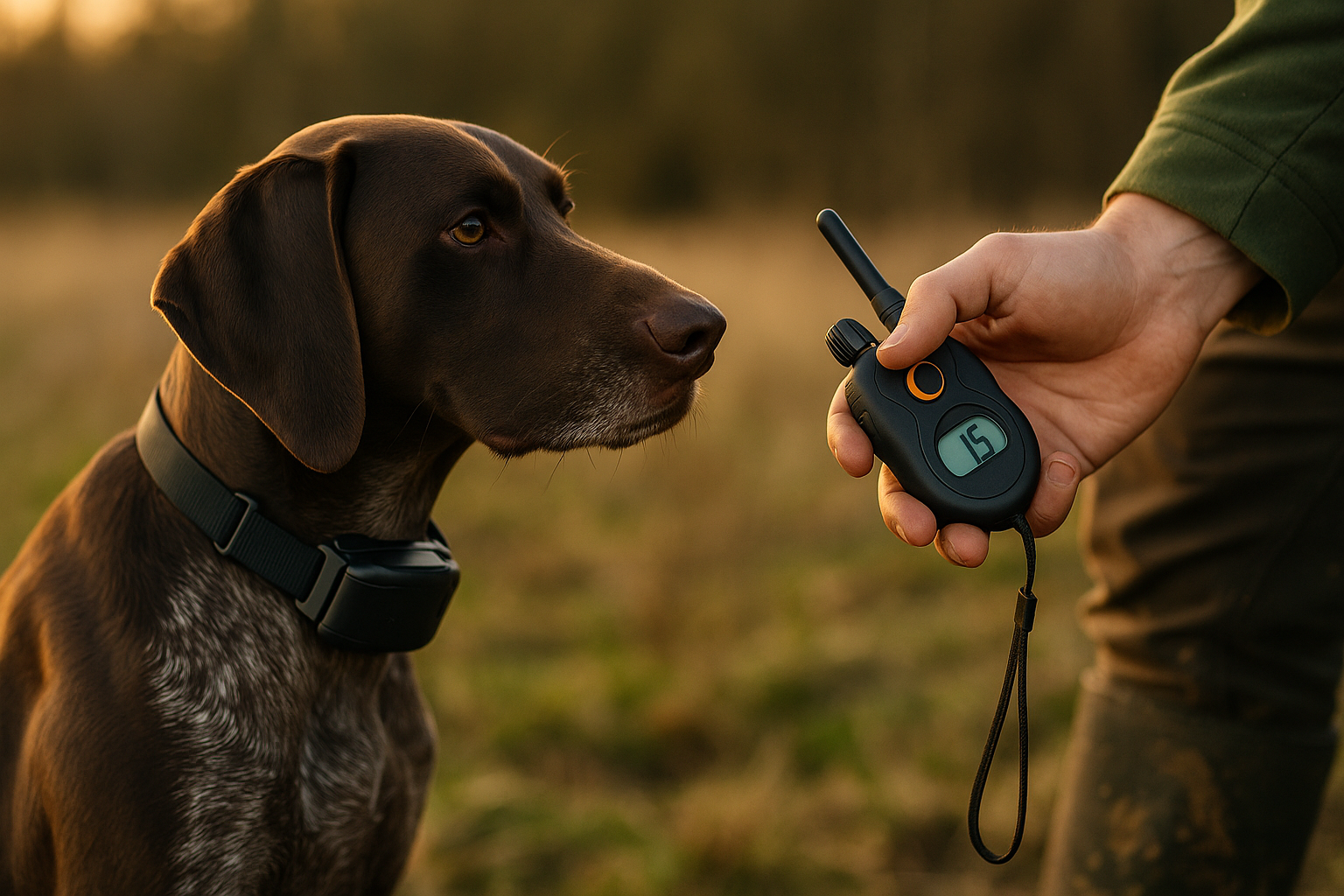
Educator ET-300 Mini Review: Small Transmitter, Big Control
If dog training had a goldilocks remote, this would be it. The ET-300 Mini fits your hand like a stopwatch, gives you surgical level control over stimulation, and—when you set it up right—makes off-leash work feel less like herding chaos and more like having a conversation.
Quick Verdict
The Educator ET-300 Mini is the go-to “first serious remote” for pet owners who want pro-grade control without an overbuilt learning curve. You get 1/2-mile advertised range, 100 levels of static with a customizable boost (1–60), tone or vibration, a night-tracking light, and a floating, waterproof transmitter that won’t ghost you if you drop it in a pond.
Real-World Fit & Feel
Pick up the ET-300 transmitter and your thumb naturally finds tone/vibration, while your index/middle fingers sit on the stim buttons. That shape isn’t an accident; Educator designs this transmitter to be used “no-look,” so your eyes stay on the dog, not on a screen. The blue backlit display is legible without staring, and the Lock & Set feature keeps the stimulation level where you want it—no accidental bumps when you’re stuffing the remote into a pocket. A built-in LED on the receiver doubles as a night tracking light for dusk walks and late retrieves.
Field note: if you train around water or wet grass, the floating, waterproof transmitter is a quiet lifesaver. If it slips out of your hoodie, you’re not diving with a magnet. (Manufacturer catalogs and Amazon copy both note floating/waterproof construction.)
What you actually get
-
Range: 1/2 mile (line-of-sight, ideal conditions; expect less in trees/hills/suburbs).
-
Stimulation: 100 levels (fine granularity) + 1–60 Boost for high arousal moments; tone or vibration mode available.
-
Power/Water: Waterproof system, receiver LED; transmitter floats; ~2-hour fast charge on Li-Po packs.
-
Dog size: Typically 5 lb+ (receiver is compact and light).
-
Build: Assembled in the USA; remote is impact-resistant.
Reality check: Range numbers are like EPA mileage—best case. Your suburban cul-de-sac with garages, trees, and Wi-Fi soup will cut it down. That’s not a flaw; it’s physics. (Use a long line while you proof recall.)
How the modes feel (to you, to the dog)
-
Tone → think: “Hey, listen.” Condition it as a positive cue for recall or an “end of behavior” marker; don’t make it a random beep. (Garmin/Educator manuals treat tone as a user-defined cue—works great as recall if you pay it.)
-
Vibration → silent attention tap; ideal for deaf or hearing-impaired dogs or when you’re training in quiet spaces. Some dogs shrug it off; condition it before you rely on it.
-
Static → lowest perceivable nudge to cut through fixation when tone/vibration fail. You’re chasing a head turn, not a hop. With 100 levels, you can match a relaxed yard session or a deer-drunk sprint without jumping from whisper to airhorn.
Pros & Cons
✅ Pros
- Compact “stopwatch” remote is truly no-look and glove-friendly.
- 100 levels + Boost (1–60) = precise control in calm or chaos.
- Tone or vibration modes; LED tracking light on receiver.
- Floating, waterproof transmitter; field-safe around creeks/duck blinds.
- Fast charge (~2 hours) and reliable battery life for daily sessions.
- Assembled in the USA; robust aftermarket parts (straps, comfort pads).
❌ Cons
- Half-mile spec is theoretical; suburbs/woods shorten usable range.
- No native smartphone app or GPS—this is a training tool, not a tracker.
- Learning curve if you’ve only used “beep/vibe/shock” budget collars.
- Small transmitter is easy to misplace (floats, but still—attach the lanyard).
- Requires good fit and timing to shine (avoid over-leveling).
Specs & feature claims above are documented on the manufacturer site and Amazon listing.
Who should buy the ET-300 Mini (and who shouldn’t)
Buy if you want pet-to-pro headroom: reliable recall, off-leash heel, steadiness around wildlife, and you value fine level control in a compact package. Skip if you want a GPS tracker, e-fence, or a collar that manages two+ dogs from day one (though you can expand to two dogs later with a second receiver).
Setup in 10 minutes
-
Fit correctly: Seat the receiver at 4–5 o’clock (off the windpipe). Tight enough not to rotate on a head shake; re-check in 10 minutes when the dog relaxes. (Manufacturer fit guidance + our fit guide.)
-
Find recognition level: In low distraction, starting from 0, dial up to the first consistent orient (ear flick/head turn), then lock your level. (Pet brands teach this “recognition level” approach across their lines.)
-
Condition tone or vibration as an attention/recall cue: cue → come → party (food or toy). Keep 5–10 easy reps.
-
Proof under distractions: If the dog blows off two cues chasing a squirrel, use momentary static at recognition +1; release the instant the dog orients; mark and reward the turn-in. (Use a long line until consistent.)
-
Rotate positions during the day; ≤ ~12 hours wear; daily skin check. (Always good practice; night LED is handy for evening checks.)
How it compares
-
ET-300 (this unit): 1/2-mile, compact RX-090 receiver, 100 levels + boost, tone/vibe, LED.
-
ME-300 Micro Educator: Built for very small dogs; 1/3-mile; ultra-compact receiver; tone/vibe/static with boost and lock & set.
-
EZ-900 Easy Educator: Same 1/2-mile class but adds programmable modes (including Continuous up to ~10s and multiple vibration/tone behaviors). Strong if you want PC-tunable profiles.
Translation: ET-300 is the “balanced daily driver;” ME-300 is the scooter for tiny necks; EZ-900 is the hot-hatch with the custom ECU tune.
Common mistakes (and easy fixes)
-
Loose collar, rising levels. If the receiver rotates on a head shake, your level is lying. Fix the fit; levels come back down.
-
Tone/vibe as nagging noise. Give tone one meaning (recall or end-of-behavior) and pay it so the dog stays responsive.
-
Holding continuous too long. Prefer momentary taps for precision; if you ever use continuous on advanced models, keep it very short—manufacturers cap it for a reason.
-
Jumping from 0 to “whoa.” Use that 100-step ladder. The goal is a polite nudge that wins attention, not a startle.
Buy it here
The Amazon listing confirms 1/2-mile range, 100 levels, Pavlovian tone, 60-level boost, waterproof to 500 ft, and a floating transmitter.

Internal linking
-
Pillar: Best Dog Training Collars
-
How-to: How to Fit an E-Collar Correctly
-
Mode guide: Tone vs Vibration vs Static
FAQ
Is the ET-300 powerful enough for big, stubborn dogs?
Yes—100 levels + 1–60 boost gives headroom. “Power” is less important than fit and timing; with proper contact and a calm recognition level, you won’t need to crank it.
Does the remote really float?
Yep. The Amazon listing explicitly calls out a floating transmitter; third-party pro retailers note it as well.
Can I train two dogs?
You can add a second receiver (becomes ET-302 functionality). If you want two transmitters paired to the same receiver (house + truck), Educator sells 2T versions.
Is it okay to use only vibration?
If your dog consistently responds—yes. Many handlers use vibration as a silent attention cue. If arousal breaks through vibration, use lowest perceivable momentary static as a safety net, then mark/reward the turn-in.
Final Take
If you want a minimal remote that talks to your dog with precision, the ET-300 Mini is that quiet professional. It doesn’t try to be everything (no app, no GPS); it just works, everywhere, in your hand, with levels that let you whisper when the dog’s brain is loud. Fit it right, start low, pay generously—and watch your recall go from “hope” to “habit.”